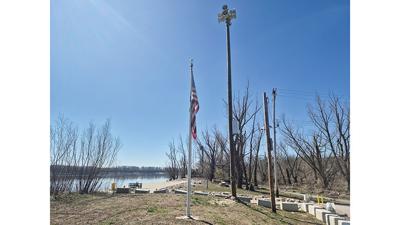The process to install new severe weather warning system sirens around Jefferson County has started and is expected to be completed next year, said Warren Robinson, Jefferson County Office of Emergency Management director.
However, the system may be partially operational in the next couple of months, he said.
The system, which will include 101 sirens mounted on utility poles and two central control units, will alert people in unincorporated areas of the county about dangerous weather with a series of loud tones, Robinson said.
Robinson said the first siren was installed in February in Kimmswick County Park, 5900 Mississippi St., near the Kimmswick Port.
He said on March 21 that he didn’t have an exact count of how many other sirens had been installed, but he believes 30 to 40 sirens would need to be installed before the system is partially activated.
“We are hoping to be able to bring the system online in a limited capacity in a month to two months,” he said. “It is going to take through spring of next year to get all of these sirens in place and operational. Because of the way the system is put together, once we get the backbone of it and a few sirens up, we can turn it on and add sirens to expand the service area piece by piece.”
Jefferson County Council members agreed in October to award a $2,248,396.74 contract to ATI Systems Inc. of Boston, Mass., to provide the system. As of March 21, the project was still on budget, Robinson said.
He said there has been a lot of interest in the new system since storms on March 14 produced a tornado that touched down near Clayton Huskey Road north of Hillsboro and went into Arnold, causing lots of property damage along the way.
“I don’t know for sure that we will have an active siren system in place by the end of this severe weather system, which goes through the end of May, but we might have a few online by then,” Robinson said. “We are excited about that.”
The county’s goal is to cover 2,000 or more people per square mile with each siren.
According to county documents, 94 of the sirens will be “tone only,” meaning they will not project recorded voices during emergencies. Seven of the sirens will have voice and tone capabilities, which will explain why the system has been activated and will provide instructions on what to do, such as finding the nearest shelter.
When it’s in place, the system will be activated automatically when the National Weather Service sends out an emergency warning for an area, Robinson said.
He said the two central control units will be located at the Office of Emergency Management building and one of the Jefferson County 911 Dispatch’s buildings, adding that the ATI System is the same one that Arnold has had since 2007.
“The system itself is going to be interoperable with the city of Arnold’s outdoor warning system,” Robinson said. “The two will be linked together electronically. If something were to come to pass and our central control units went down, we could rely on the city of Arnold to activate our sirens. On the flip side, if something happened to Arnold’s, we could act as a backup activation system for them as well.”
“We have done our best to keep the locations on county-owned property or in county rights-of-way,” he said.
However, the locations for about 10 of the sirens have not been finalized because the county doesn’t own the recommended locations for them, Robinson said. If the county can’t acquire the easements needed to put those sirens in their recommended locations, they may have to be installed elsewhere on county property, which could be too far away from their ideal locations.
“For coverage, that is not a good thing,” he said. “We are reaching out to state and public agencies to find closer alternatives.”
Robinson said the county is doing its best not to place the sirens too close to homes and businesses. However, he said due to the density of homes in some areas, the sirens may be installed near houses.
“We do our best to not place them next to someone’s house. I understand the desire to not have that,” he said. “I hope members of the public understand that these are not sirens that we will activate just for the heck of it. When these sirens go off, it is going to be during a life-threatening situation. They are not being put there to harass the public. They are being put there in the name of public safety.”
Robinson said the county has not established a formal calendar of when the system will be tested after it is fully installed. The system is designed to detect problems internally, so sirens will not always have to be turned on to ensure they are operating correctly.
However, he said there will be times when the system is activated when there is not a severe weather event.
“Occasionally, we are going to run tests to ensure the sirens are operational and to help the public understand what it will sound like when they go off,” he said.




